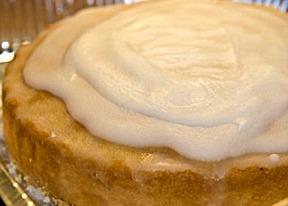
Cake and photo by odettaganda, Premium Member © Sarah Phillips
This pound cake, amply flavored with lemon and orange peel, after baking, can have an moist apricot filling inserted into the cake, making it a great party or everyday cake. The flavor combinations are perfect with a cup of hot or iced tea. Be sure to include a sprig of fresh mint and a lemon slice with your drink.
CAKE RECIPE HELP
INGREDIENTS
2 cups sifted bleached cake flour; sift flour onto a sheet of waxed paper. Then spoon flour into measuring cup and level to rim.
1/4 teaspoon salt
2 sticks (1 cup or 16 tablespoons) unsalted butter
1 1/3 cups sugar
5 large eggs
2 teaspoons vanilla
2 teaspoons lemon peel (1 lemon)
2 teaspoons orange peel (1 orange)
For the dried apricot filling, optional
1/3 cup dried apricots
1/3 cup water
INSTRUCTIONS
1. Position rack in middle of the oven. Heat oven to 350 degrees F. Coat a 9- x-5- x 3-inch loaf pan with nonstick cooking spray. Set aside.
2. Sift the flour and salt onto a sheet of waxed paper. Set aside.
3. Beat the butter in the bowl of a stand mixer, fitted with a paddle attachment, on low until softened. (If the butter is cold, it will warm quickly from the beaters – taking about 60 seconds).
4. Maintaining the same speed, add the sugar in a steady stream at the side of the bowl. Increase speed to medium and beat for 1 minute until the butter is lighter in color and aerated.
5. Stop the mixer and scrape the side and bottom of the bowl with a large rubber spatula.
6. With the mixer on low, add the eggs one at a time and beat for 20 seconds after each addition. Beat in the vanilla, lemon and orange peels.
7. Then increase the mixer speed to medium and beat the mixture for 2 minutes. (If the eggs are cold, the batter will curdle slightly. It's ok. It will come together as the batter warms from the beaters. ) Set the kitchen timer to help you keep track of the time.
The mixture will become fluffy and aerated.
8. With the mixer on LOW speed, add about one-third of the flour mixture at a time. Scrape the sides of the bowl often and mix until smooth after each addition. Do not overmix.
After completing the last addition of flour, stop the mixer, and scrape the side and bottom of the bowl with a large rubber spatula.
9. Spoon the batter into the prepared pan. Lightly smooth its top.
9. Bake for 50 to 55 minutes, or until a wooden toothpick inserted in the center comes out with a few moist crumbs, but not batter. The cake's crust should be golden and should begin to contract from the pan sides.
SARAH SAYS: The cake will peak and crack in the center as it bakes as a result of aeration and because it is a heavy batter
10. Place the cake on a rack to cool for 5 to 10 minutes. Loosen the sides with a small metal spatula or sharp knife, taking care not to scratch the cake pan.
11. Invert onto cake rack and place on its side to cool completely. Be careful, the cake is delicate when warm.
MAKE THE APRICOT FILLING
No more than 30 minutes before filling the cake, begin the apricot filling.
1. Place the apricots in a 1-quart heavy-bottomed saucepan. Pour the water over them and allow to soak for 5 minutes.
2. Bring the mixture to a boil over medium heat. Reduce the heat to medium-low and simmer until almost all the water is evaporated, taking about 5 to 7 minutes.
2. Fit a food [processor with a metal blade. While the apricot mixture is still warm, pulse it until it has a sticky paste consistency.
FILL THE CAKE
1. Once the cake has completely cooled, trim the top of the cake to make it level. Then turn it upside down, making the top of the cake the base.
2. With the tip of a small paring knife, lightly trace a V on one short end of the cake, beginning at the corners of the seam (that is, where the sides meet the top) and ending just below the middle of the cake. Each side or leg of the V should be about 2 1/2 inches long (depending on the size of your cake, of course). Turn the cake around, and do the same to the other end of the loaf.
3. Insert the paring knife into the lines you have traced to the depth of about 1/2 inch. Do this to every corner of the cake. These notches will serve as a guide for cutting a deep V-shaped piece that will be lifted out of the pound cake. Position the cake directly in front of you, with one of its short ends parallel to the edge of the counter. Taking the right side first, insert a 12-inch serrated knife into both notches, and slowly saw diagonally down that side of the V. Check often to ensure that the knife is staying in the notch and following the correct angle. Turn the cake around, and repeat the procedure on the other side. Carefully lift the triangular portion from the body of the cake, and set aside.
4. Using a metal spatula, spread a thin, even film of the dried apricot filling into the valley you have created in the cake. Then replace the triangular piece, pressing down gently to fit it into place. The filling should not be too apparent, and the cake should look almost as it did before being cut.
STORAGE
If you plan to serve the cake within 24 hours, wrap it in plastic wrap and store at room temperature. Refrigerate cake after that for a few days. Freeze for a month.
Recipe is adapted from Flo Braker.


